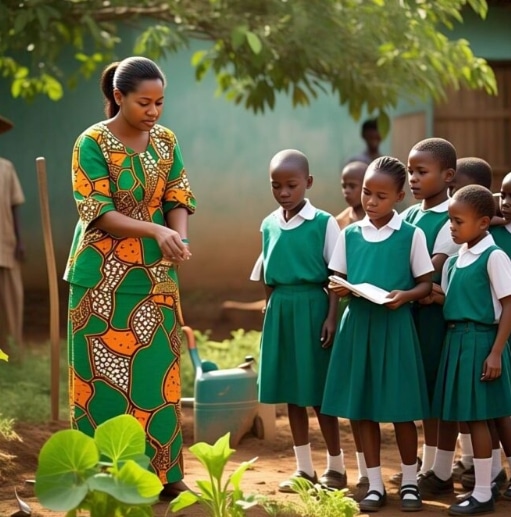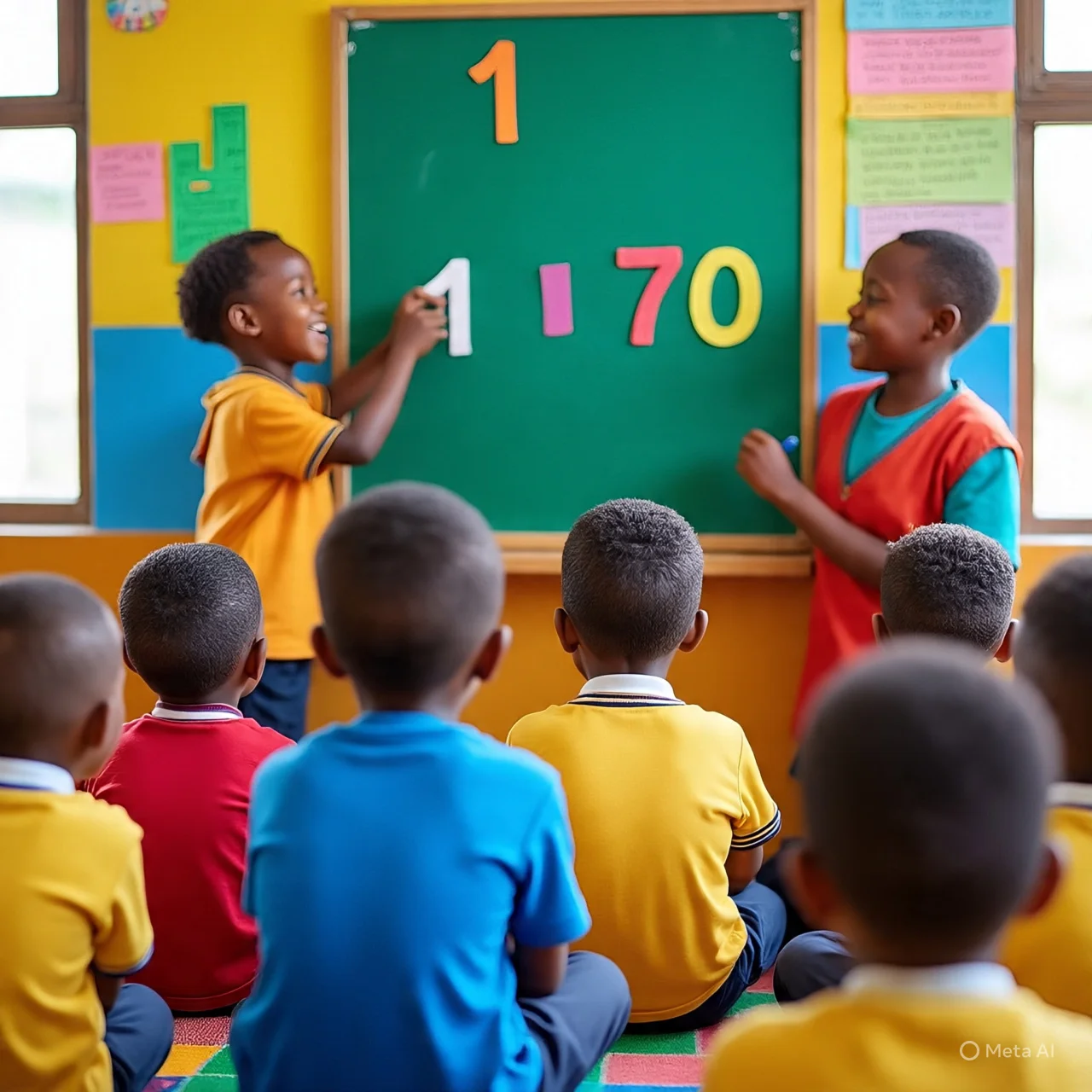BASIC SCIENCE AND TECHNOLOGY
PRIMARY 1 – SECOND TERM – WEEK 8
TOPIC: COLOUR IDENTIFICATION
Sub-Topic: Primary and Secondary Colours
Age: 5–6 years
Duration: 40 minutes
1. Behavioural Objectives
By the end of the lesson, pupils should be able to:
- Define colour in simple terms.
- Identify at least 5 objects with their natural colours.
- Mention the three primary colours.
- Mention the three secondary colours.
- State the two colours in the Nigerian flag.
- Explain how secondary colours are formed.
- Recognize colours in their classroom environment.
- Match objects to their correct colours.
- Classify colours as natural, primary, or secondary.
- Appreciate the beauty and importance of colours in daily life.
2. Keywords (At Least 10) With Meaning
- Colour – How an object looks when light shines on it.
- Shade – The lightness or darkness of a colour.
- Primary Colours – First colours used to make other colours (red, yellow, blue).
- Secondary Colours – Colours made by mixing two primary colours (green, orange, violet).
- Mixing – Joining two colours to make a new one.
- Object – Anything we can touch or see.
- Natural Colour – The real colour an object has.
- Appearance – How something looks.
- Flag – A cloth used as a symbol for a country.
- Symbol – A sign that stands for an idea or meaning.
3. Set Induction (Attention-Grabbing Story)
The teacher tells this short story:
“Children, yesterday on my way home, I saw something funny! A small boy was crying because he said he lost his ‘red shoe’. But when I looked down, the shoe he was wearing was actually blue! He didn’t know the difference! His mother laughed and said, ‘Ah! My son, colours help us know things well.’
“Today, we will not make the same mistake as that boy. We will learn colours like champions!”
Pupils respond with excitement.
4. Entry Behaviour (Aligned to Your Persona)
Pupils already know basic objects like tomatoes, leaves, fruits, pencils, books, and can describe them.
The teacher asks:
“Class, what colour is your school uniform? What colour is the board?”
They answer confidently.
5. Learning Resources
- Real classroom objects (chalk, leaves, pencils, erasers).
- Colour flashcards.
- Crayons.
- Picture charts.
- Nigerian flag.
- A simple colour wheel.
6. Building Background / Connection to Prior Knowledge
The teacher reminds pupils of previous lessons on light energy, explaining that we see colours because light helps our eyes.
7. Embedded Core Skills
- Observation skills
- Creative thinking
- Communication skills
- Colour recognition
- Sorting and classification
8. Reference Books
- Lagos State Unified Scheme of Work for Basic Science
- Nigeria Primary Science Textbook 1
- Universal Basic Education Curriculum (UBE)
9. Instructional Materials
- Chart showing primary and secondary colours
- Pictures of objects with natural colours
- Crayons
- Whiteboard markers
- Nigerian flag
10. Content (Well-Structured & In-Depth)
A. Meaning of Colour
Colour is how an object looks when light shines on it. It helps us identify things easily.
Examples of objects and their natural colours:
- Cotton – white
- Tomatoes – red
- Leaves – green
- Wood – brown
- Sun – yellow
- Sky – blue
- Charcoal – black
- Sand – brown
- Orange fruit – orange
- Grass – green
B. Primary Colours
These are the first colours used to make other colours.
Primary Colours Are:
- Red
- Yellow
- Blue
Examples of objects with primary colours:
- Stop sign – red
- Banana – yellow
- Sky – blue
- Fire truck – red
- School ruler (plastic) – yellow
C. Secondary Colours
These are colours formed when two primary colours are mixed.
Examples:
- Green = Yellow + Blue
- Orange = Red + Yellow
- Violet (Purple) = Red + Blue
Objects with secondary colours:
- Leaves – green
- Carrots – orange
- Grapes – violet
- Watermelon rind – green
- Guinea corn stalk – orange
D. Colours of the Nigerian Flag
- Green – stands for agriculture and wealth
- White – stands for peace
11. Evaluation Questions
A. 10 Fill-in-the-Blank (Multiple Choice)
- Tomatoes are ______ in colour.
a) blue b) red c) black d) pink - Leaves are ______.
a) green b) purple c) orange d) white - The sun is ______.
a) yellow b) red c) brown d) black - Red, yellow, and blue are ______ colours.
a) natural b) fine c) primary d) dull - Green is a ______ colour.
a) secondary b) primary c) dark d) bright - ______ + blue = green.
a) yellow b) red c) pink d) brown - The Nigerian flag has ______ colours.
a) 2 b) 4 c) 1 d) 3 - White stands for ______.
a) peace b) soil c) night d) heat - Blue + red = ______.
a) orange b) purple c) green d) white - Cotton is ______.
a) red b) black c) white d) blue
B. 10 Short Answer Questions
- What is colour?
- Give one example of a natural colour of an object.
- Mention two primary colours.
- Mention two secondary colours.
- What colours make orange?
- What colour is wood?
- What colour is the Nigerian flag?
- What does green stand for?
- What does white stand for?
- Give one example of something that is yellow.
12. Class Activity Discussion (10 FAQs With Answers)
- Q: Why do we need colours?
A: Colours help us identify things easily. - Q: Are tomatoes red naturally?
A: Yes. - Q: Can we mix colours?
A: Yes, mixing makes new colours. - Q: Are green and orange secondary colours?
A: Yes. - Q: What colours make purple?
A: Red and blue. - Q: What colour is the sky?
A: Blue. - Q: Is black a colour?
A: Yes. - Q: Why do flags have colours?
A: They show meaning and identity. - Q: Is yellow a primary colour?
A: Yes. - Q: What does white on the Nigerian flag stand for?
A: Peace.
13. Presentation Structure
- Teacher revises last topic (Light Energy).
- Teacher introduces the new topic (Colours).
- Teacher demonstrates with objects.
- Pupils participate actively.
14. Teacher’s Activities
- Display colour charts.
- Explain natural, primary, and secondary colours.
- Demonstrate colour mixing.
- Ask pupils to identify colours around them.
- Supervise activities and correct errors.
15. Learners’ Activities
- Observe objects and state their colours.
- Repeat colour names aloud.
- Match objects to colours.
- Draw and colour simple objects.
- Participate in class discussion.
16. Assessment (Short Answer)
- Define colour.
- Give two primary colours.
- What colour is the sun?
- What colour is cotton?
- What two colours make green?
- Mention two secondary colours.
- State one colour in the Nigerian flag.
- What does green stand for?
- What does white mean?
- Name one object that is red.
17. Conclusion
Teacher checks pupils’ work, marks, and gives supportive feedback.
18. SEO ELEMENTS
Captivating Title (Under 60 Characters)
Colour Identification for Primary 1 (Natural, Primary & Secondary)
Focus Keyphrase
Colour Identification Primary 1
SEO Title
Colour Identification Primary 1 | Basic Science Week 8
Slug
colour-identification-primary-1-basic-science
Excerpt
A complete Primary 1 lesson note on Colour Identification, including natural, primary, and secondary colours with examples, evaluation, and activities.
One-Word Keyword
Colour
Meta Description (Under 160 Characters)
Learn Colour Identification for Primary 1. Covers natural, primary, and secondary colours with examples, activities, and evaluation.
19. Internal Links
- Lesson on Light Energy (internal)
- Lesson on Things Found in the Soil (internal)
- Lesson on Soil Types and Importance (internal)
20. External Links
WEEKLY EXPLANATION PLAN (MONDAY–FRIDAY)
Topic: Colour Identification
Class: Primary 1
⭐ MONDAY – Understanding What Colour Means
1. Meaning of Colour
Colour is the way an object looks when light shines on it. Colour helps us know things easily.
2. In-Depth Explanation
Every object has a colour.
Colour makes things beautiful.
Colour helps us identify objects quickly.
Without colour, everything will look dull.
Light helps us see the true colour of things.
3. Examples of Things and Their Colours
- Cotton – white
- Tomato – red
- Leaves – green
- Wood – brown
- Sun – yellow
4. Classroom Demonstration Examples
- Teacher shows a white paper.
- Teacher shows a red pencil.
- Teacher points to green chalkboard.
- Teacher shows brown desk.
- Teacher draws a yellow circle for the sun.
⭐ TUESDAY – Primary Colours
1. Meaning of Primary Colours
Primary colours are the main colours that cannot be made by mixing other colours.
2. In-Depth Explanation
They are the “parent” colours.
They help in creating other colours.
There are only three primary colours.
They are often used in painting and design.
Once mixed, they produce new colours.
3. The Three Primary Colours
- Red
- Yellow
- Blue
4. Everyday Examples of Primary Colours
- Red – blood, apple, fire extinguisher
- Yellow – school bus, banana, egg yolk
- Blue – sky, jeans, ocean
5. Classroom Demonstration Examples
- Red marker
- Yellow chalk
- Blue pencil
- Red school bag
- Blue water bottle
⭐ WEDNESDAY – Secondary Colours
1. Meaning of Secondary Colours
Secondary colours are colours made by mixing two primary colours.
2. In-Depth Explanation
They come from combining “parent” colours.
They are brighter and more colourful.
Artists use them often to design.
Children see them in toys and cartoons.
They help decorate classrooms and homes.
3. Secondary Colours and How They Are Formed
- Green = yellow + blue
- Orange = red + yellow
- Violet (purple) = red + blue
4. Real-Life Secondary Colour Examples
- Green – grass, vegetables, Nigerian flag
- Orange – oranges, carrot, traffic cone
- Violet/Purple – zobo drink bottle, flowers, beads
- Green – chalkboard paint
- Orange – sunset sky
⭐ THURSDAY – Colours Around Us
1. Meaning
Colours are everywhere around us and help us recognize objects safely and quickly.
2. In-Depth Explanation
Colours help in traffic rules.
Colours help identify school uniforms.
Colours help doctors, drivers, and teachers.
Colours help us avoid danger (e.g., red light).
Colours help make learning interesting.
3. Examples of Colours Around Us
- Traffic lights:
- Red = stop
- Yellow = get ready
- Green = go
- School materials:
- Blue notebooks
- Yellow pencils
- Nature:
- Green grass
- Red soil in some parts of Nigeria
- Homes:
- Brown doors
- White ceilings
- Food:
- Green vegetables
- Orange mangoes
⭐ FRIDAY – Colours in the Nigerian Flag + Revision
1. Meaning of the Colours in the Nigerian Flag
The Nigerian flag has two colours: green and white.
2. In-Depth Explanation
- Green stands for agriculture and wealth.
- White stands for peace and purity.
These colours remind us to love our country and work hard.
3. Examples of Each Colour in the Flag
Green examples:
- Green leaves
- Green vegetables
- Green school field
- Green chalkboard
- Green traffic “go” light
White examples:
- White cotton
- White paper
- White school socks
- White clouds
- White chalk
4. End-of-Week Revision Activities
- Identify colours around the classroom
- Mix paints to form new colours
- Match objects to their colours
- Colour the Nigerian flag
- Sort items by colour groups











